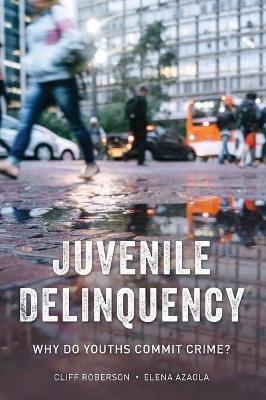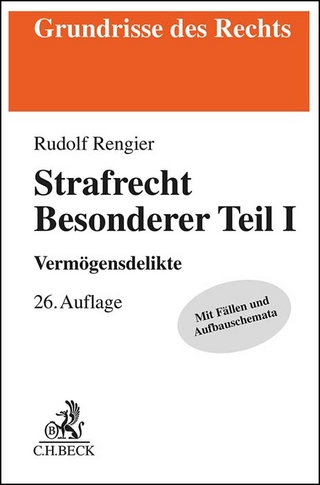
Juvenile Delinquency
Rowman & Littlefield (Verlag)
978-1-5381-5194-5 (ISBN)
Juvenile Delinquency: Why Do Youths Commit Crime? focuses on why juveniles commit crime. It includes discussions on what constitutes criminal behavior by juveniles, the general theories on delinquency, and discussions that tie the theories with real life situations. The book opens the students’ eyes to the fascinating concepts involving juvenile delinquency, and is designed to provide a complete study of the behavior, beliefs, conditions, and reactions to deviance by young offenders.
Throughout Cliff Roberson and Elena Azaola gives students a detailed discussion of and what constitutes juvenile delinquency to allow for better understanding of this phenomenon. In each of the chapters, the authors encourage the student to develop new insights on criminal behavior of juveniles. The book makes the subject come alive by the generous use of “down to earth” examples of the issues involved in the area. While each chapter builds on the previous chapters, the book is written in a manner to reduce the necessity of memorization by students. Each chapter begins with chapter objectives that highlights key points for the student and brief chapter outlines. Each chapter closes with a practicum, chapter summary, and discussion and review questions which enhance student learning. The book closes with a glossary where student may refer to they key terms and words throughout the text.
Cliff Roberson is former managing editor in chief of the journal Police Practice & Research, an international journal that is distributed in over 50 countries. In addition, he is an Emeritus Professor at Washburn University and retired Professor of Criminology at California State University, Fresno. Elena Azaola, PhD, is a professor at the Center for Advanced Studies and Research in social anthropology located in Mexico City. She has published more than 150 journal articles and numerous books on human behavior, crime, and human rights. Presently Azaola is working on a United Nations funded research on developing “Standards for Mexican Prisons.”
Preface
Acknowledgements
Part I: Juveniles Delinquency Overview
Chapter 1: Introduction to the Study of Juvenile Delinquency
Chapter objectives
Overview of juvenile delinquency
Defining adolescence and lack of a uniform definition
Types of Juvenile Misconduct
Measuring Delinquency
Goals of the Juvenile Justice System
Factors that influence juvenile behaviors
Overview of delinquency theories
Crime and Age
Female Delinquency
Overview of federal action on juvenile Justice
Practicum
Summary
Discussion and Review Questions
Chapter 2: Issues Involving Juvenile Delinquency
Chapter objectives
Do We Need A Separate Court System?
Juveniles Involved in Sex Trafficking
Primary Purpose of Juvenile Justice Courts?
Juvenile Incarceration Funding
Privately-Operated Juvenile Institutions
School to Prison Pipeline
Juveniles Who Commit Violent Crimes
Pathways to Desistance
Bullying
Cyber Delinquency
Practicum
Summary
Discussion and Review Questions
Part II: Delinquency Causation Theories
Chapter 3: Classical and Positivists Concepts
Chapter objectives
Delinquency Behaviors
Early Theories of Delinquency
Classical Concepts
Free Will
Rational choice
Mental Capacity Defenses
Early Positivist Concepts
Biological Explanations of Delinquency
Psychological Concepts
Practicum
Summary
Discussion and Review Questions
Chapter 4: Social Structure Concepts
Chapter objectives
Causation Theories
Anomie
Social Structure Processes
Strain
Subcultural Theories
Institutional anomie theory
Symbolic Interaction Theories
Ecological Theories
Practicum
Summary
Discussion and Review Questions
Chapter 5: Social Process and Integrated Theories
Chapter objectives
Social Control Theories
Social Bond Theories
Conflict Theories
Critical Theories
Social Learning Theories
Multi-Factor Theories of Crime
Integrated Theories
Control Balance Theory
Differential Coercion Theory
Practicum
Summary
Discussion and Review Questions
Part III Delinquency Influences
Chapter 6: Families & Peers Delinquency Influences
Chapter objectives
Family Influences
Early Childhood Disruptive Behavior
Functional Family Theory
Peers and Delinquency
Practicum
Summary
Discussion and Review Questions
Chapter 7: Youth Gangs
Chapter objectives
Youth Gang Issues
Defining Youth Gangs
History of Youth Gangs
Gang Indicators
Indicators of Youth Gang Involvement
Dynamics of Youth Gangs
Why Youths Join Gangs
Consequences of Gang Membership
Preventing Gang Membership
Promising Programs for Dealing with Youth Gangs
National Youth Gang Center
Practicum
Summary
Discussion and Review Questions
Chapter 8: Juveniles and Police
Chapter objectives
Police and Juvenile offenders
Police Discretion
School Resource Officers
Police and Rule of Law
Practicum
Summary
Discussion and Review Questions
Part IV Juvenile Justice System
Chapter 9: Juvenile Justice
Chapter objectives
Development of Juvenile Justice
Juvenile Justice Reform
Development of Dependency Jurisdiction
U.S. Supreme Court and the Rights of Juveniles
Practicum
Summary
Discussion and Review Questions
Chapter 10: Juvenile Court Hearings
Chapter objectives
Overview
The Petition
Jurisdictional or Intake Hearing
Adjudicatory hearing
Rights at Juvenile Hearings
Appealing A Juvenile Adjudication
Persons Involved in the Hearings
Reponses and Plea Bargaining
Practicum
Summary
Discussion and Review Questions
Chapter 11: Juvenile Corrections
Chapter objectives
Juvenile Probation
Conditions of Probation
Interstate Compact on Juveniles
Juvenile Probation Officers
Restorative Justice
Revocation of Probation
Practicum
Summary
Discussion and Review Questions
Chapter 12: Juvenile Institutions
Chapter objectives
Overview
Sexual Violence in Juvenile Institutes
Residential Treatment
Juvenile Parole
Types of Institutions
Aftercare
Does Detention make them worst?
Massachusetts Experience
Practicum
Summary
Discussion and Review Questions
Chapter 13: Transfers to Adult Criminal Court
Chapter Objective
Overview
Statistics on Waivers
Waiver of Jurisdiction
Double Jeopardy and the Wavier Decision
Right to Appeal Waiver
Direct Filing in Adult Criminal Court
Practicum
Summary
Discussion and Review Questions
Chapter 14: Enhancing Juvenile Protection
Chapter objectives
Termination of Parental Rights
Protective Orders
Disclosure of Juvenile Information
Expunction of Juvenile Records
Dual System Youths
Juvenile Competency Procedures
Juvenile Drug Courts
Teen Courts
Status Offenses
Practicum
Summary
Discussion and Review Questions
Chapter 15: Comparative Review of Juvenile Justice and Delinquency
Chapter objectives
Overview
United Nations Standards on Juvenile Justice
United Nations World Youth Report
Comparative Study of Youth Crime
Australia
Canada
China
France
Great Britain
India
Japan
Practicum
Summary
Discussion and Review Questions
Author Bios
| Erscheinungsdatum | 10.05.2021 |
|---|---|
| Verlagsort | Lanham, MD |
| Sprache | englisch |
| Maße | 189 x 267 mm |
| Gewicht | 885 g |
| Themenwelt | Recht / Steuern ► EU / Internationales Recht |
| Recht / Steuern ► Strafrecht ► Besonderes Strafrecht | |
| Recht / Steuern ► Strafrecht ► Kriminologie | |
| ISBN-10 | 1-5381-5194-4 / 1538151944 |
| ISBN-13 | 978-1-5381-5194-5 / 9781538151945 |
| Zustand | Neuware |
| Haben Sie eine Frage zum Produkt? |
aus dem Bereich


